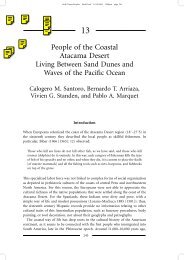Geographical distribution of Tillandsia lomas in the Atacama ... - IEB
Geographical distribution of Tillandsia lomas in the Atacama ... - IEB
Geographical distribution of Tillandsia lomas in the Atacama ... - IEB
Create successful ePaper yourself
Turn your PDF publications into a flip-book with our unique Google optimized e-Paper software.
550ARTICLE IN PRESSR. P<strong>in</strong>to et al. / Journal <strong>of</strong> Arid Environments 65 (2006) 543–552and annual herbs such as Polyachyrus and Cristaria among o<strong>the</strong>rs. At this siteT. landbeckii was also detected grow<strong>in</strong>g on cacti.10. Quebrada Rio Loa: This <strong>Tillandsia</strong> loma community was only recorded through an airsurvey. It is composed <strong>of</strong> isolated stands to <strong>the</strong> north <strong>of</strong> <strong>the</strong> Loa river west <strong>of</strong> CerroQuebradillas (21123 0 S, 96158 0 W).4. DiscussionOf <strong>the</strong> 15 species recorded <strong>in</strong> <strong>the</strong> coastal desert <strong>of</strong> Peru, eight <strong>of</strong> <strong>the</strong>m form <strong>Tillandsia</strong><strong>lomas</strong>. From <strong>the</strong>se only three are present <strong>in</strong> <strong>the</strong> coastal <strong>Atacama</strong> Desert <strong>in</strong> nor<strong>the</strong>rn Chile:T. landbeckii, T. marconae and T. virescens. The <strong>Tillandsia</strong> <strong>lomas</strong> <strong>in</strong> Chile are formed byT. landbeckii and T. marconae, be<strong>in</strong>g T. landbeckii <strong>the</strong> dom<strong>in</strong>ant species.Accord<strong>in</strong>g to Rauh (1985a) <strong>the</strong> sou<strong>the</strong>rn limit <strong>of</strong> <strong>Tillandsia</strong> <strong>lomas</strong> is located <strong>in</strong> Iquique.However, our data shows that <strong>the</strong>y are also found fur<strong>the</strong>r south near <strong>the</strong> Loa River. Thesou<strong>the</strong>rn limit <strong>of</strong> <strong>Tillandsia</strong> <strong>lomas</strong> is probably set by <strong>the</strong> <strong>in</strong>tensity <strong>of</strong> fog flux, and thisdecreases for north to south along <strong>the</strong> coast <strong>in</strong> nor<strong>the</strong>rn Chile (Larraı´n et al., 2002).Similarly, <strong>the</strong> altitud<strong>in</strong>al limits as well as how far <strong>in</strong>land <strong>the</strong>se communities can develop, islikely set by fog moisture availability. In fact, Cereceda et al. (2002) report a drasticdecrease <strong>in</strong> fog fluxes when compar<strong>in</strong>g coastal (3 km from coastl<strong>in</strong>e) aga<strong>in</strong>st <strong>in</strong>land (12 kmfrom coast) sites (8.5 and 1.1 l m 2 day 1 , respectively).At a f<strong>in</strong>er scale, <strong>Tillandsia</strong> loma communities are strongly associated with <strong>the</strong> coastaltopography and located <strong>in</strong> areas where <strong>the</strong>re is enough fog and where <strong>the</strong> <strong>in</strong>landpenetration <strong>of</strong> moisture is allowed (e.g. areas serv<strong>in</strong>g as fog corridors along <strong>the</strong> CoastalCordillera see Cereceda et al., 2002). In Arica <strong>the</strong>se areas are associated to deeps rav<strong>in</strong>es.In Iquique <strong>in</strong>stead <strong>the</strong>y are associated with corridors formed when high altitudes (around1300 m) are present near <strong>the</strong> coastl<strong>in</strong>e and where <strong>the</strong> cliff is relatively lower (400–600 m)allow<strong>in</strong>g fog entry. Deep rav<strong>in</strong>es allow fog penetration at greater distances from <strong>the</strong> coast.This fact can be observed at Lluta Valley, where <strong>Tillandsia</strong> <strong>lomas</strong> are found at 45 km from<strong>the</strong> coast. In Tacna, sou<strong>the</strong>rn Peru, <strong>the</strong> coastal cliff disappears and <strong>the</strong> slope s<strong>of</strong>tly climbsfrom <strong>the</strong> coast allow<strong>in</strong>g greater <strong>in</strong>land fog entrance where <strong>the</strong>y go as far as 60 km from <strong>the</strong>coast. The fog corridors that feed <strong>the</strong> two larger <strong>Tillandsia</strong> loma systems are locatedbetween Iquique and Patache (20113 0 S and 20148 0 S). The largest concentrations <strong>of</strong>cont<strong>in</strong>uous <strong>Tillandsia</strong> stands are located at <strong>the</strong> start<strong>in</strong>g end <strong>of</strong> <strong>the</strong>se corridors, 8 km from<strong>the</strong> coast. They are located <strong>in</strong> sandy pla<strong>in</strong> areas and are fed by <strong>the</strong> sand that is carried by<strong>the</strong> w<strong>in</strong>d from <strong>the</strong> large dune formations located to <strong>the</strong> west.<strong>Tillandsia</strong> <strong>lomas</strong> <strong>in</strong> Chile, as <strong>the</strong> ones <strong>in</strong> sou<strong>the</strong>rn Peru, are located only <strong>in</strong> <strong>the</strong> upperborder <strong>of</strong> <strong>the</strong> fog ecosystems. The only <strong>Tillandsia</strong> loma that shares its habitat with shrubbyand herbaceous vegetation is found at Cerro Chipana, which is <strong>the</strong> one closest to <strong>the</strong> coast(3 km). They are generally monospecific communities as <strong>in</strong>dicated by Rundel et al. (1997);however, we found two exceptions to this trend: <strong>the</strong> <strong>Tillandsia</strong> loma found at Portezuelo dePoconchile <strong>in</strong> Arica that comprises two species: T. marconae and T. landbeckii and <strong>the</strong> one<strong>in</strong> Cerro Carpas and Cerro Isla <strong>in</strong> Iquique where T. landbeckii shares its habitat with asmall population <strong>of</strong> T. virescens.In general, most records <strong>of</strong> <strong>Tillandsia</strong> <strong>in</strong> Chile have been l<strong>in</strong>ked to <strong>the</strong> presence <strong>of</strong> roads,which <strong>in</strong> part expla<strong>in</strong>s why most authors believed that <strong>Tillandsia</strong> were only restricted to avery few spots <strong>in</strong> nor<strong>the</strong>rn Chile (e.g. Abele, 1981; Rauh, 1985a, b; Rundel et al., 1997;
















